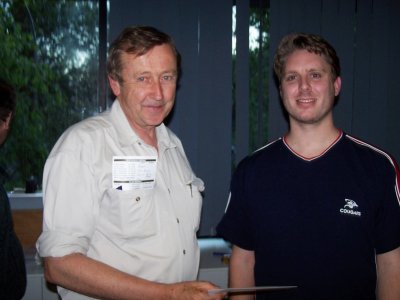These days there are Laws and Rules for every situation. There is The Rule of Two, The Rule of Three, right up to The Rule of 26. There is the Losing Trick Count and The Law of Total Tricks, to name just the most popular two. Plus countless conventions. Nevertheless the “Do You Like Your Hand’ Convention predates all of these.
Say you hold. ![]() A4
A4 ![]() AJ9652
AJ9652 ![]() KQ2
KQ2 ![]() 87
87
and your partner raises your 1![]() opening bid to 2
opening bid to 2![]() . There is no suit in which you want to make a game try, but you’d like to say to partner that aces and kings and trump honours are all good. Try a “Do You Like Your Hand’ bid of 3
. There is no suit in which you want to make a game try, but you’d like to say to partner that aces and kings and trump honours are all good. Try a “Do You Like Your Hand’ bid of 3![]() .
.
Holding:
![]() K4
K4 ![]() KQ4
KQ4 ![]() 10863
10863 ![]() 9632 Bid4
9632 Bid4![]() , you like your hand with three important honour cards
, you like your hand with three important honour cards
![]() QJ4
QJ4 ![]() Q43
Q43 ![]() 10863
10863 ![]() QJ3 Pass. you don’t like your hand, your queens and jacks aren’t what partner wants
QJ3 Pass. you don’t like your hand, your queens and jacks aren’t what partner wants
Now imagine at both vulnerable partner opens 4![]() in first seat, and you hold:
in first seat, and you hold:
![]() A63
A63 ![]() A4
A4 ![]() A9865
A9865 ![]() A104 Blackwood won’t help. With lots of controls this is the perfect time for the DYLYH Convention. Just bid 5
A104 Blackwood won’t help. With lots of controls this is the perfect time for the DYLYH Convention. Just bid 5![]() . Opener just asks themselves that simple question:
. Opener just asks themselves that simple question:
![]() 84
84 ![]() KQJ109652
KQJ109652 ![]() 2
2 ![]() 87 Pass, you don’t like your hand, too flat
87 Pass, you don’t like your hand, too flat
![]() 8
8 ![]() KO107643
KO107643 ![]() 2
2 ![]() KJ87 Bid 6
KJ87 Bid 6![]() , you like your hand, two singletons and a nice side suit
, you like your hand, two singletons and a nice side suit
In our last example you open 1NT on:
![]() A108
A108 ![]() K53
K53 ![]() AQ6
AQ6 ![]() A985
A985
and the bidding proceeds:
| 1NT | 2 |
(Transfer) |
| 2 |
3 |
(Second Suit and Game Force) |
| 3 |
4 |
|
| ??? |
3![]() was strong preference, but responder showed no slam interest by not cue bidding. You have the perfect maximum. All of your cards are jewels and partner needs very little extra for slam. Do you meekly pass. or make a try for slam. Keycard wont do you much good, you really want to know if partner has that litle extra? So you bid 5
was strong preference, but responder showed no slam interest by not cue bidding. You have the perfect maximum. All of your cards are jewels and partner needs very little extra for slam. Do you meekly pass. or make a try for slam. Keycard wont do you much good, you really want to know if partner has that litle extra? So you bid 5![]() , lots of controls, and “Do you like your hand’. Holding:
, lots of controls, and “Do you like your hand’. Holding:
![]() QJ3
QJ3 ![]() AQJ64
AQJ64 ![]() 106432
106432 ![]() Pass, your queens and jacks won’t fetch
Pass, your queens and jacks won’t fetch
![]() 3
3 ![]() AQ642
AQ642 ![]() K732
K732 ![]() Q103 Bid 6
Q103 Bid 6![]() , you have that little extra.
, you have that little extra.
In general when are not sure whether to pass or go the full distance, remember to ask yourself that defining question. “Do I like my hand”? It could even become your favourite convention.
Esta entrada también está disponible en: Spanish


